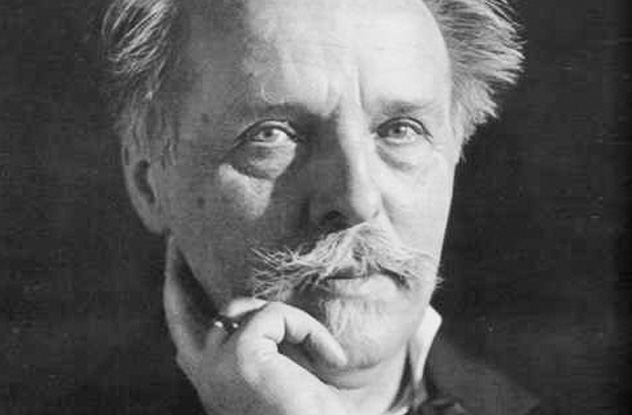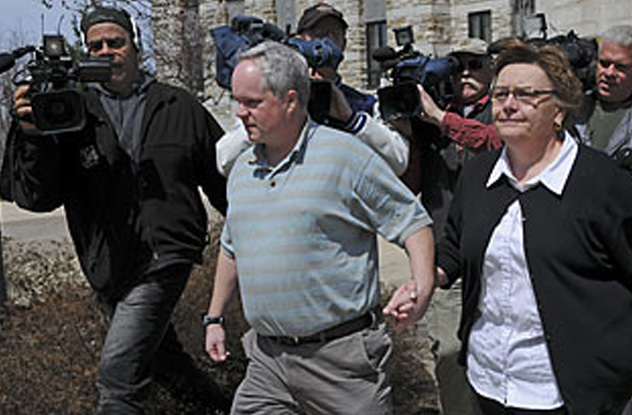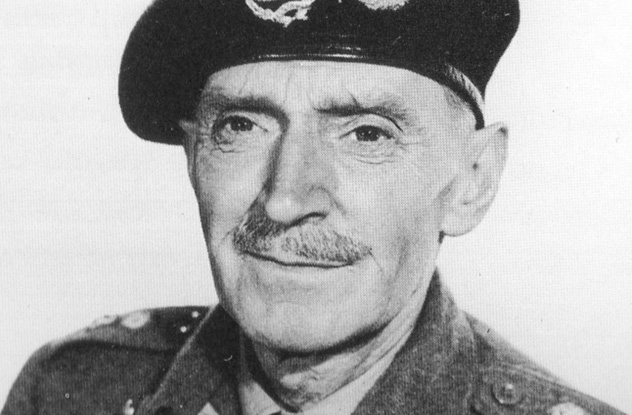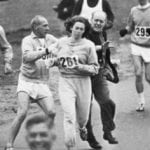10Joseph Manuella
If you spotted Joseph Manuella walking down the street, you might nervously ask the man for his autograph. He’d probably give you one, too, and chances are good he’d sign his name “Robert De Niro.” Manuella bears an uncanny resemblance to the two-time Oscar winner, and he’s put his looks to good use. The former fireman from New Jersey is a Robert De Niro impersonator, showing up at parties and spouting classic likes like “You talkin’ to me?” Manuella even doubled for the real De Niro, acting in movies like The Fan and Great Expectations. There’s nothing wrong with impersonating a celebrity. Just look at all the middle-aged men with sagging stomachs, greasy pompadours, and sparkly jumpsuits. However, there are limits, and telling impressionable young women you’re an A-list movie star and inviting them to your home is generally considered out of bounds. In 2001, Manuella was busted after using his facial features to win free food at pricey restaurants and complimentary rooms at fancy hotels. The con man never slept alone. He was always accompanied by some starstruck fan, convinced she was stepping out with one Hollywood’s greatest actors. Manuella crashed parties in the Hamptons, got a credit card in De Niro’s name, and scammed fans out of cash. One story goes he even conned the head honcho at Sony Pictures. The man allegedly shook Manuella’s hand and thanked him for everything he’d done for the company. Whether or not that particular tale is true, Manuella successfully fooled quite a few people, until the real De Niro discovered what was going on. Manuella wasn’t exactly the wisest wise guy in the world and actually tried to get his own movie. When De Niro found out, he asked the cops to set up a sting operation. Manuella’s crime spree finally came to a halt after he was invited to perform at a Holiday Inn where the authorities were waiting. A short time later, he was facing two counts of criminal impersonation. However, Manuella got off pretty lightly. The con artist pleaded guilty, and his sentence was reduced to a charge of disorderly conduct. Instead of facing jail time, Manuella was soon back on the street and working on a short film about his life, which he submitted to the Tribeca Film Festival—a festival founded by De Niro himself.
9Barry Bremen
Not every impostor is out for ill-gotten gain. All Barry Bremen wanted was a few laughs. A Detroit salesman who peddled toys and novelties to retail stores, Bremen spent his free time crashing sporting events and award ceremonies. His odd little hobby started in 1979 when he swiped a basketball jersey, crept into Detroit’s Pontiac Silverdome, and started warming up with the rest of the NBA stars. Bremen was about 193 centimeters (6’4″) and fooled everyone in the arena . . . for a couple of seconds, before he was tossed out. The year 1979 was busy for Bremen. In addition to his basketball hijinks, he donned a New York Yankees uniform and caught a few pop-ups, but one of his most infamous moments was when he posed as a Dallas Cowboys cheerleader. After shaving his legs, losing 10 kilograms (23 lb), and practicing dance moves inside his living room, Bremen successfully made his way onto the Texas field. Unfortunately, despite his self-described “great legs,” Bremen was caught after delivering a single cheer. Dallas officials didn’t take kindly to his cross-dressing gag and threatened to sue Bremen and permanently ban him from all future Cowboys games. Luckily, they eventually lightened up and dropped the charges. After the cheerleader fiasco, Bremen disguised himself as The San Diego Chicken, played a few practice rounds in the US Open, and was ejected from a baseball game by the legendary Tommy Lasorda. However, there was one stunt Bremen actually felt bad about. In 1985, he tried to accept the Best Supporting Actress Emmy for Hill Street Blues star Betty Thomas. Bremen thought Thomas wasn’t in the audience, so when she came walking down the aisle, it was awkward for everyone. The great impostor died in 2011 at the age of 64. Before he shuffled off this mortal coil, he left one last piece of wisdom for any other impostors out there. “Don’t do it,” he said. “It’s against the law. Stay away. This is my act.”
8Gavin Bain & Billy Boyd
Gavin Bain and Billy Boyd were college dropouts with a dream. They wanted to become big-time rappers. But Bain and Boyd were Scottish, and nobody in the music business took their accent seriously. The duo reinvented themselves as Silibil n’ Brain, two American rappers from California. And just like that, they were a major hit. They signed with Sony UK in 2004 and started hanging out with stars like Madonna and Rod Stewart. They appeared on MTV, were endorsed by clothing companies, and Bain even got an American girlfriend who totally bought his fake accent. However, things almost fell apart when they met D12, the hip-hop group featuring Eminem. The duo had claimed they were friends with the Dirty Dozen, so when they were introduced to the group, Boyd walked right up to Proof (one of the members) and gave him a big hug. Either confused or incredibly polite, Proof acted like Boyd was an old friend. Of course, no good con lasts forever. Boyd and Bain knew that if they released an album, somebody would recognize them, and the dream would collapse. Desperate, they stalled the album for as long as possible, but in the meantime, their personal lives fell apart. Bain became an alcoholic, and a despondent Boyd soon headed back to Scotland, ending their hip-hop careers. The rappers were featured in a documentary, and Bain became a family man with his own clothing store. Boyd founded a rock band, but the man struggled with his fall from fame for a long time. Not only did he attempt suicide, but for two years after the breakup, Bain was still speaking with an American accent.
7The Unknown Scientist
Unlike the other impostors on this list, the “Unknown Scientist” is, well, unknown. While he was arrested multiple times, no one ever discovered his true identity. And though articles about his exploits popped up in Science magazine and The New York Times, he successfully scammed scientists for seven years. From 1884–1891, the con man introduced himself to paleontologists, geologists, and chemists across the US. The crook often claimed he was the relative of a renowned scientist or said he represented respected institutions like the Smithsonian or Cornell. He frequently pretended to be deaf and mute and sometimes claimed he was Russian. He operated under names like E.D. Strong, N.R. Taggart, and Professor H.S. Williams. Sometimes, he mentioned serving in the military and fighting Native Americans. The man knew his science. He gained his victims’ trust by engaging them in lengthy discussions about fossils, and after they gave him access to public museums and private collections, he’d pilfer valuable books, rare specimens, and scientific instruments. Then he’d sell his goods and take off to a new town. While word of the thief spread across the country, no one could stop him for long. The Unknown Scientist swindled great minds from New York to Iowa, and while he appeared to have some sort of deformity (some said his right arm was crippled; others said he was missing his left hand), no one could ever pin him down or learn his true identity. In fact, he once he swindled the same scientist twice, using two different personas. Eventually, he was sentenced to five years in an Ohio penitentiary, but after he was paroled, the Unknown Scientist vanished into thin air.
6Karl May
Back in 19th-century Germany, Karl May was a literary superstar. This mustachioed author penned 82 novels and created one of Germany’s most iconic characters: Winnetou. This brave Apache chief roamed the American West, fighting for justice and righting wrongs, always accompanied by his German sidekick, Old Shatterhand. The Winnetou novels were best sellers and earned May (pronounced “My”) nationwide recognition and truckloads of money. When he published his first Winnetou tale, In the Distant West, May implied it was a true story. He also implied that he himself was Old Shatterhand, Winnetou’s right-hand man. In truth, he’d never set foot outside of Germany. May was actually an ex-teacher and part-time thief who’d served time for stealing furs. But the public didn’t know any better, and they devoured May’s fantasies, thinking them travelogues. As May gained fame, his claims grew wilder. Whenever May went on tour, he sported a buckskin jacket and a crazy sombrero. He would chant in Apache and claim to speak a multitude of languages. He bought a fancy house, dubbed it “Casa Shatterhand,” and filled it full of mementoes he’d supposedly collected on his travels. May even built a cabin for Winnetou in the backyard, in case the Apache chief decided to drop by for a visit. When real Native Americans toured Germany in Wild West shows (and didn’t act anything like the Native Americans in his books), he claimed they were liars, outcasts from their tribes. May even claimed the legendary Buffalo Bill Cody caused the death of a couple of his friends. The lies were spinning out of control, and everything came crashing down on May when reporters discovered the truth about his past. Despite the bad press, May’s novels kept on selling. They were beloved by everyone from Albert Einstein to Adolf Hitler. They spawned a series of popular German movies and even inspired an annual Winnetou festival, though the books were all wildly inaccurate. When May finally came to America in 1908, just a few years before he died, he visited the Museum of Natural History in Manhattan and was absolutely devastated. He learned Apaches didn’t actually live in pueblos. Nor did they build totem poles. Texas deserts weren’t at all like sandy Arabian wastelands, and all those battles he’d set in the 1860s actually occurred in the 1810s. May was so distraught that he ventured no further west than New York.
5William Melchert-Dinkel
Englishman Mark Drybrough, 32, was struggling with depression, and he turned to suicide prevention chat rooms. There, he met Li Dao. A nurse in her twenties, Li wasn’t interested in saving Mark’s life. Instead, she encouraged him to hang himself. Mark was one of five people who killed themselves thanks to Li. Many of her victims made suicide pacts with her, planning to share their final moments with the nurse via webcam, but Li never followed through. In fact, she wasn’t even a woman. Li was a middle-aged white man named William Melchert-Dinkel. He lived in Minnesota, and while he was a real-life nurse, the man had a disturbing history. William had been accused of abusing nursing home patients, and when he wasn’t hurting the elderly, he was hunting for depressed people online. Some of his victims were impressionable teenagers who’d been sexually abused, but instead of offering help, “Li Dao” explained how to tie a proper knot and told victims things would be much better in heaven. And while he denied it to authorities, it seems William watched some of his victims die from the comfort of his computer room. The nurse was arrested thanks to Celia Bay and Kat Lowe, two amateur detectives who discovered Li Dao’s real sex, name, and whereabouts. The father of two was arrested and sentenced to three years for “advising and encouraging” the deaths of Mark Drybrough and an 18-year-old Canadian woman. However, after the Minnesota Supreme Court determined it was unconstitutional to convict someone for giving advice, William received a new sentence of 178 days in jail for assisting their suicides.
4Charity Johnson
Charity Stevens was 16-year-old girl in Longview, Texas, a chubby teen who lived with 30-year-old Tamica Lincoln. Tamica wasn’t Charity’s real mother, but she bought her clothes, gave advice for her teenage troubles, and treated Charity like her very own kid. Only Charity wasn’t a kid. She was a 34-year-old adult named Charity Johnson. And Lincoln was just one of many women across the US who’d invited Johnson into their homes, eager to help a troubled child. For years, Johnson friended these women on Facebook, claiming she was the victim of abuse and needed somewhere to stay. With her youthful face, hair bows, and Hello Kitty clothing, it was easy to fall for Charity’s teenage charm. She chatted with women across the country, ending up with “moms” in Maryland, New Jersey, North Carolina, and Texas. Charity wasn’t out for cash. She just wanted someone to care for her. Charity Johnson had had a rough childhood. Her mother was an abusive junkie who beat, traumatized, and eventually abandoned her daughter. Charity spent most of her teen years living in a group foster home in Austin. Perhaps it’s because of her horrific childhood that Johnson pretended to stay a teen, hoping to find a loving mother. Unfortunately for Charity, her con fell apart in 2013 when one of her many adoptive mothers contacted Tamica Lincoln, and the women put two and two together. Unsure what else Charity was capable of, Lincoln phoned the police, who arrested Johnson for failing to identify herself to a cop. (She gave the officer multiple aliases and fake birthdays.) Johnson was released after a few days in jail and today works at a McDonald’s in an undisclosed Texas town. She’s supposedly dropped her teenager act and says she no longer contacts women on Facebook. Despite her lies, it’s hard to judge Charity. In fact, many of her marks still want to help her. As one of her victims explained, “She’s not a con artist for money. She’s a con artist for love.”
3Bob Lambert
Just like James Bond, Bob Lambert was a spy who specialized in seduction. But the women he wooed weren’t sexy assistants working for maniacal super-villains. They were real-life people, used and abused in one of the most corrupt undercover operations in UK history. Lambert was a member of the Special Demonstration Squad (SDS), a British unit that spied on protesters the government labeled subversive. In the early ‘80s, Lambert was assigned to keep an eye on England’s radical environmentalists, but he first needed a dead kid. Before going undercover, SDS officers stole identities of deceased children with similar names and birth dates. Lambert chose Bob Robinson, a seven-year-old who died in 1959. After investigating Robinson’s story, Lambert prowled around the environmentalist scene, posing as a London Greenpeace activist. (Despite the name, London Greenpeace is unaffiliated with Greenpeace.) He attended group meetings and protests, and that’s how he met Jacqui, a twenty-something animal lover who fell for Lambert’s charms. Jacqui was phase two of Lambert’s plan: seduce an environmentalist and start a relationship. Soon, the two even had a son named Francis. It was the perfect cover. Lambert vanished every so often, supposedly to visit his dad with dementia. Actually, he was visiting his wife and two kids. Lambert eventually joined up with radicals from the Animal Liberation Front (ALF) and captured several eco-terrorists. However, some believe Lambert went too far with his method acting and actually helped ALF bomb several retail stores. Whether or not that’s true, Lambert’s mission soon came to an end, and in 1987, he abandoned Jacqui and his young son. Jacqui didn’t see Lambert again, not until over 20 years later when she saw his picture in the paper. Since their days together, Lambert had served as head of operations at SDS and was currently working in the world of academia. Then a group of activists learned his true identity and outed the spy in public. With journalists now digging in his past, Lambert admitted that he’d seduced Jacqui and three other women as part of his undercover operations. He wasn’t the only one. Numerous SDS officers stole identities from deceased children, and at least nine used sex to gain information. Now that he was exposed, Lambert apologized for his actions and even befriended Francis, the son he’d left behind. But Jacqui wasn’t so forgiving. She and 10 other women sued the Metropolitan Police Force, and in 2014, Jacqui was awarded £425,000 for her pain and suffering.
2M.E. Clifton James
M.E. Clifton James was one of many actors on the London stage. Born in Perth, Australia in the late 1890s, James fought for king and country during World War I and even lost a finger. When World War II rolled around, James reenlisted, putting his acting skills to use by entertaining the boys. Then this middle-aged thespian was offered the role of a lifetime. In the weeks before D-Day, the British wanted to divert Hitler’s attention from Normandy. Their plan was to find a body double for Bernard Montgomery, the English general in charge of all Allied land forces, and send him to the Mediterranean. If this Monty look-alike was seen in Gibraltar, the Nazis would assume the Allies were massing an invasion from the south instead of attacking Normandy. The quest for a Monty impersonator was a little difficult. Their first choice was too tall, and their second broke his leg. Finally, somebody spotted M.E. Clifton James. The old boy looked almost identical to the “Spartan General” and often cracked up audiences with his Montgomery impersonations. So when James was briefed on the situation and offered a full general’s pay for his time, how could any self-respecting actor say no? James spent the next few weeks observing Montgomery, noting his walk, his quirks, and his accent. The Australian, who was a big drinker and heavy smoker, was probably crushed to learn Montgomery abhorred alcohol and nicotine. Nevertheless, James threw himself into the role. For his missing finger, British officials ordered a prosthetic, and James was soon flown to Gibraltar to fool the Nazis. When James arrived in the British territory, he met with the governor (who was in on the scam) and even inspected a few troops. After his visit to Gibraltar, James went to Algiers and then on to Cairo, where he received a bottle of whiskey for a job well done. And just like the British had hoped, a Nazi spy had spotted the fake general in Gibraltar and immediately phoned the Germans. While there’s debate over how effective the ploy was, it was still a great moment in the history of espionage. When the war was over, James turned his story into a book, which was adapted into the film I Was Monty’s Double. Ever the showman, James played both himself and Montgomery.
1Shi Pei Pu
When Bernard Boursicot arrived in China in the early ‘60s, he was a 20-year-old accountant for the French Embassy. A lonely and naive man, Boursicot was sexually inexperienced. He’d had a few trysts with classmates back at his all-boy boarding school, but now he wanted to fall in love with a woman. Then he met Shi Pei Pu. The 26-year-old opera singer, playwright, and Chinese instructor looked and dressed like a man, but as the two became friends, the librettist confessed that he was actually a woman in disguise. According to Shi, her mother needed a son to live up to familial pressure. So when she gave birth to a girl, Shi’s mom claimed her daughter was a boy, plunging them both into a lifelong charade. Bernard was stunned and smitten all at once. Soon, the two were a couple, but their sex life was really weird. Their lovemaking sessions were rare, very brief, and always in the dark. Bernard just assumed Shi was incredibly modest. If he had any concerns about her masculine body, Shi put them to rest by explaining she took hormones. During their long love affair, Bernard often left China to visit other countries. On one occasion, he returned to find Shi had given birth to a son, but the boy wasn’t around. The political situation in China was tense, and Chairman Mao didn’t exactly smile on Westerners, so Shi was forced to send her half-French son to hide along the Russian border. This anti-Western sentiment impeded Bernard and Shi’s relationship. Wherever they met, the two were under constant surveillance. Once, a group of angry villagers even stormed their home, accusing the couple of espionage. Worried he was putting his love in danger, Boursicot agreed to spy for the Chinese government. Over the next several years, Bernard stole numerous documents from the French embassy, and Shi sometimes acted as his middleman. Shi finally introduced Bernard to his seven-year-old son, Shi Du Du. However, the trio wasn’t a happy family. Boursicot was sent to Mongolia, where he continued spying for the Chinese, but eventually, the accountant returned to France and moved in with a male lover. Regardless, Boursicot still had feelings for his Chinese family, and in 1982, he arranged for Shi and their son to move into his home. Then, things fell apart. Curious why a member of the Foreign Service was living with a foreigner, French officials investigated Boursicot’s past and quickly discovered his double agent lifestyle. In 1983, both Bernard and Shi were arrested, and Boursicot made a shocking discovery that he surely should have made years before. A prison examination revealed that Shi Pei Pu was male. Suddenly, their lovemaking sessions in the dark made sense. As for Shi Du Du, Shi had bought their supposed son from an impoverished mother. Infuriated, Boursicot cut his own throat. The Frenchman survived his suicide attempt, and both spies were sentenced to six years behind bars. However, perhaps because none of the documents Boursicot stole were that important, both men were pardoned just a few months later. The two never reunited, and Shi died in 2009, ending one of history’s weirdest love affairs.
























